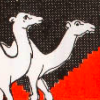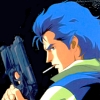Ninja Gaiden: Dragon Sword (DS) review"With Dragon Sword, Team Ninja has taken a game known for brutal, in-your-face action and made the switch to a control scheme that is far more unconventional and alien to those experienced with Ninja Gaiden. It could have been a disaster Ė that itís actually a relatively smooth, entertaining action game (on a handheld, no less) should serve as a testament to the skills the team possesses, especially in an area as potentially hostile as DS development." |
In reviewing Ninja Gaiden: Dragon Sword for the DS, I will say nothing of my intense hatred for the popular Xbox game on which it is based. Itís irrelevant. That gameís problem was its camera; the new DS title uses fixed perspectives on pre-rendered environments. Camera is no longer a problem with Dragon Sword, and I knew that going in. So please donít accuse me of being the ďwrongĒ person to review this game, because as it just so happens, I enjoyed it quite a bit.
Pre-rendered backdrops are hardly the only compromise Team Ninja made in the creation of Dragon Sword. The DS version of the acclaimed action series is controlled almost entirely with the stylus, a bold and dangerous move that makes the game feel like something of an experiment, but a successful experiment, at that. You may recall that Nintendo did something similar to the Zelda series with Phantom Hourglass, though that project was more destined for success due to the nature of that franchise. With Dragon Sword, Team Ninja has taken a game known for brutal, in-your-face combat and made the switch to a control scheme that is far more unconventional and alien to those experienced with Ninja Gaiden. It could have been a disaster Ė that itís actually a relatively smooth, entertaining action game (on a handheld, no less) should serve as a testament to the skills the team possesses, especially in an area as potentially hostile as DS development.
Youíll hold your DS sideways, Brain Age-style, as you guide returning hero Ryu Hayabusa through the numerous levels that compose this five-hour quest. Controlling the game entirely by touch works precisely as youíd think it would: Drag the stylus across the screen to move Ryu about, swipe up to make him jump, slice horizontally to make him whip out his sword and attack, or lightly tap a spot on the screen to make him fire whatever projectile weapon heís carrying. Buttons are used only to make Ryu block attacks; an on-screen icon can be tapped to activate magic spells. Itís a simple enough setup that youíll have mastered it in a minute.
Limiting control to the stylus creates a few problems by default. For one, itís not all that precise. Dragon Sword thankfully isnít a very demanding game and wisely chooses to focus almost entirely on action, and in these cases its setup works fine. Itís where Team Ninja asks us to perform tricky platforming stunts or dodge booby traps that the game falters, because this kind of control scheme by its very nature is very accident-prone. The game occasionally confuses touch screen inputs, as well Ė like if you want Ryu to move up the screen, heíll often jump first. That kind of thing.
The other problem is that, all said and done, itís just not very deep. Ryu has a couple of fancy combos he can unleash against his enemies (and theyíre used accidentally about as often as theyíre used intentionally), but for the most part, just about any intense situation is cleared by repeatedly swiping across the touch screen like a maniac as you watch Ryu wreak havoc upon his foes. Five hours may not seem like much, but Dragon Sword is repetitive enough that I fear it would have grown old had Team Ninja drawn out the adventureís length any more.
But it doesnít get old, thanks to the sheer satisfaction gained from clearing through wave after wave of enemy warriors with nothing more than a thin, plastic stylus. Itís games like Dragon Sword that make me understand just what Nintendo had in mind when they first unveiled the DS four years ago. When a control setup is limited to buttons, thereís always that wall of isolation between the player and the character, as if youíre not so much controlling him as simply telling him what to do. In Dragon Sword, every swipe that went through my foes was one personally delivered by my own hand. Iím more involved and it feels good.
Team Ninja isnít afraid to exploit the simplistic nature of the game by basing it around equally simple level design. Each chapter is essentially just a set of rooms, each of which is packed with respawning enemies you must defeat. Once you do, you move on to the next room and repeat. (Youíll see some halfhearted puzzle elements thrown in there, too, almost out of necessity.) There isnít even much variation between your foes as the game progresses, other than looks. There neednít be. The game is mindlessly enjoyable on its own terms, and youíll find yourself demanding little more than a new supply of beasties to vanquish with each passing level.
Each chapter caps off with a boss battle, and itís here that Dragon Sword shows the most potential, dropping its pre-rendered locales in favor of fully 3D arenas. Dragon Sword is always a good looking game, but during these encounters it becomes a phenomenal looking one, with each boss beautifully grotesque in its own right. While the game controls the same, the 3D environments allow the camera to swoop down behind Ryu, constantly centered on the boss in question. Apparently, the guys at Team Ninja figured out that itís best to have the camera facing toward the enemies! Huh! (Sorry, I said I wouldnítÖ) Itís during these battles that Dragon Sword provides its greatest challenge, too, as itís otherwise a relatively easy game Ė though the unlockable Head Ninja difficulty will send you home in a body bag.
Dragon Sword can best be labeled as an experiment, but itís easy to see the promise delivered from as unlikely a developer as Team Ninja. For as many issues as I have with the game, itís at least fresh to see someone utilizing the DS hardware to its fullest rather than simply slapping a map onto the second screen and calling it a DS exclusive. Dragon Sword has me hoping more developers will attempt the transition to fully touch-operated gameplay, and restores a great deal of my confidence in Team Ninja. I canít wait to see what these guys do next.
 |  |  |  |  |
Staff review by Mike Suskie (May 18, 2008)
Mike Suskie is a freelance writer who has contributed to GamesRadar and has a blog. He can usually be found on Twitter at @MikeSuskie. |
|
More Reviews by Mike Suskie [+]
|
|
If you enjoyed this Ninja Gaiden: Dragon Sword review, you're encouraged to discuss it with the author and with other members of the site's community. If you don't already have an HonestGamers account, you can sign up for one in a snap. Thank you for reading!
User Help | Contact | Ethics | Sponsor Guide | Links









